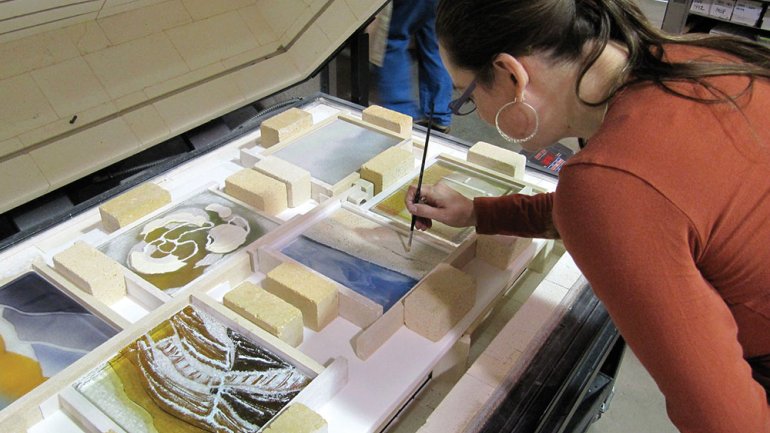See, Learn, Make
See, Learn, Make
Bullseye Resource Center
3610 SE 21st Ave.
Portland, OR 97202
503-227-2797
Bullseye Gallery
300 NW 13th Ave.
Portland, OR 97209
503-227-0222
Daniel Schwoerer, CEO, co-owner, and co-founder of Bullseye Glass Co., likes blazing a trail. His company, founded in 1974, helped put kiln-formed glass as an art form on the map. Kiln-formed glass is often called "warm" glass, but not by folks at Bullseye, who find the term misleading; it is solid glass that has been heated in a kiln and fused, slumped, or otherwise manipulated. (By contrast, glassblowing - "hot" glass - starts with liquid glass that is shaped as it cools. The two are wholly different ways of working.)
Schwoerer had the privilege of studying with studio glass pioneer Harvey Littleton at the University of Wisconsin-Madison. After graduation in 1969, a headstrong 20-something Schwoerer headed to the one city his mentor advised against: Portland, Oregon. As he began visiting West Coast craft shows in the early 1970s, he found glass artists, especially in the burgeoning stained glass window market, frustrated by the limited palette and incompatibility of the available manufactured glass lines. (Different glass formulations expand at different rates when heated. If two pieces of glass aren't compatible, they'll crack when they're fused.)
So Schwoerer and two friends, Ray Ahlgren and Boyce Lundstrom, started manufacturing a line of tested, compatible glass in lots of different colors, specifically for kiln-formers. Driving up and down the West Coast in a VW microbus, they hawked their new glass formulations at craft fairs. Before they knew it, they had a business, which gave them money and time to pursue their real goal: promoting kiln-formed glass as a fine art form and building a community of artists. The enterprise, with Lani McGregor as co-owner and partner, now consists of three entities: the glass company, the resource center (a walk-in facility that sells supplies and offers classes), and a gallery. A second resource center opened in Santa Fe in 2010, and a third is planned for 2012 in the San Francisco Bay Area.
So manufacturing came first. How did the gallery and educational programming begin?
We were more interested in learning about melting glass than actually making a product. The gallery is a natural extension of that. We'd bring in artists, and they'd do a body of work. Then that work would go to New York or Los Angeles or Zurich or somewhere, and we felt that it really needed to be shown in this community. So we said, "Hey, we'll start our own gallery!"
What role does the gallery play in the glass community?
The gallery is a way to bring emerging artists to shows like SOFA in Chicago, Collect in London, or Art Miami. We use our gallery to develop artists' careers, artists who are using our materials in kiln-forming and who are teaching. That really helps grow the community.
And this year you've integrated videos into your educational resources. How's that going?
We traveled all over the world for five or six years [in the mid-'70s] teaching classes before there was any market at all for kiln-formed glass, and the videos are just an extension of that. We have about 1,600 subscribers right now. And most of those subscribers do, at some point, sign up for a class.
How do you see kiln-formed glass growing in the future?
Kiln-formed glass is really accessible. You can produce very wonderful works of art inexpensively, relative to glassblowing, because you don't have this furnace that eats up fuel by the hour. More fine artists are coming to it. Painters and printmakers [who want to experiment with glass], especially, see the potential there. They are able to work much like they would with paint and inks.
Education has played a big part in Bullseye's success. How important is having an MFA to being a good artist?
Having an MA or MFA is very valuable, especially if you want to teach. But we represent a number of artists who don't have art degrees at all. The key is to be impassioned by what you're doing. If you're impassioned, you can be a good artist.
Andrew Zoellner is American Craft's assistant editor.

